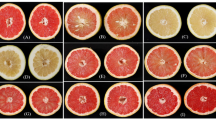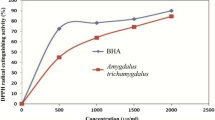Abstract
This study aimed to determine bioactive components and radical scavenging capacity of black raspberry seed extracts as byproducts obtaining during the juice (FSE) and wine (WSE) making process. Cyanidin-3-O-rutinoside was identified as a major anthocyanin and the total anthocyanin contents of fresh and wine seed were 78.24 and 41.61 mg/100 g of dry weight, respectively. The total phenolic and flavonoid contents of FSE and WSE were 2.31 g gallic acid equivalent (GAE) and 360.95 mg catechin equivalent (CE), and 2.44 g GAE and 379.54 mg CE per 100 g dry weight, respectively. The oxygen radical absorbance capacity (ORAC) values were 1041.9 μM TE/g for FSE and 1060.4 μM TE/g for WSE. Pretreatment of the FSE and WSE inhibited the generation of intracellular reactive oxygen species (ROS), DNA and protein damage induced by hydroxyl radicals, and Fe3+/ascorbic acid-induced lipid peroxidation in a dose dependent manner. WSE more effectively protected from oxidative damage than FSE. Results from the current study suggest that black raspberry seeds as byproducts from juice and wine processing could be potential sources for natural antioxidants.






Similar content being viewed by others
References
Abid-Essefi S, Ouanes Z, Hasen W, Baudrimont I, Creppy EE, Bacha H (2004) Cytotoxicity, inhibition of DNA and protein syntheses and oxidative damage in cultured cells exposed to zearalenone. Toxicol in Vitro 18:467–474. doi:10.1016/j.tiv.2003.12.011
Arts IC, Hollman PC (2005) Polyphenols and disease risk in epidemiologic studies. Am J Clin Nutr 81:317–325
Bahramikia S, Ardestani A, Yazdanparast R (2009) Protective effects of four Iranian medicinal plants against free radical mediated protein oxidation. Food Chem 115:37–42. doi:10.1016/j.foodchem.2008.11.054
Bushman BS, Phillips B, Isbell T, Ou B, Crane JM, Knapp SJ (2004) Chemical composition of caneberry (rubus spp.) seeds and oils and their antioxidant potential. J Agric Food Chem 52:7982–7987. doi:10.1021/jf049149a
Du J, Gebicki JM (2004) Proteins are major initial cell targets of hydroxyl free radicals. Int J Biochem Cell Biol 36:2334–2343. doi:10.1016/j.biocel.2004.05.012
Ehlenfeldt MK, Prior RL (2001) Oxygen radical absorbance capacity (ORAC) and phenolic and anthocyanin concentrations in fruit and leaf tissues of highbush blueberry. J Agric Food Chem 49:2222–2227. doi:10.1021/jf0013656
Ha TJ, Lee MH, Park CH, Pae SB, Shim KB, Ko JM, Shin SO, Baek IY, Park KY (2010) Identification and characterization of anthocyanins in yard-long beans (Vigna unguiculata ssp. Sesquipedalis L.) by high performance liquid chromatography with diode array detection and electrospray ionization/mass spectrometry (HPLC-DAD-ESI/MS) analysis. J Agric Food Chem 58:2571–2576. doi:10.1021/jf903883e
Han W, Hu W, Lee YM (2011) Anticancer activity of human colon cancer (HT-29) cell line from different fraction of zanthoxylum schnifolium fruits. Korean J Pharmacogn 42:282–287
Hu W, Heo SI, Wang MH (2009a) Antioxidant and anti-inflammatory activity of kalopanax pictus leaf. J Korean Soc Appl Biol Chem 52:360–366. doi:10.3839/jksabc.2009.064
Hu W, Shen W, Wang MH (2009b) Free radical scavenging activity and protective ability of methanolic extract from duchesnea indica against protein oxidation and DNA damage. J Food Sci Nutr 14:277–282. doi:10.3746/jfn.2009.14.4.277
Je JY, Ahn CB, Oh MJ, Kang SY (2009) Antioxidant activity off a red seaweed polysiphonia morrowii extract. Food Sci Biotechnol 18:124–129
Jiang L, Dai H, Sun Q, Geng C, Yang Y, Wu T, Zhang X, Zhong L (2011) Ambient particulate matter on DNA damage in HepG2 cells. Toxicol Ind Health 27:87–95. doi:10.1177/0748233710387001
Ju HK, Cho EJ, Jang MH, Lee YY, Hong SS, Park JH, Kwon SW (2009) Characterization of increased phenolic compounds from fermented bokbunja (rubus coreanus Miq.) and related antioxidant activity. J Pharm Biomed Anal 49:820–827. doi:10.1016/j.jpba.2008.12.024
Kim KH, Lee YA, Kim JS, Lee DI, Choi YW, Kim HH, Lee MW (2000) Antioxidative activity of tannins from rubus coreanum. Yakhak Hoeji 44:354–357
Kim SI, Sim KH, Ju SY, Han YS (2009) A study of antioxidative and hypoglycemic activities of omija (schizandra chinensis baillon) extract under variable extract conditions. Korean J Food Nutri 22:41–47
Kong JM, Chia LS, Goh NK, Chia TF, Brouillard R (2003) Analysis and biological activities of anthocyanins. Phytochemistry 64:923–933. doi:10.1016/S0031-9422(03)00438-2
Ku CS, Mun SP (2008) Antioxidant activities of ethanol extracts from seeds in fresh bokbunja (rubus coreanus Miq.) and wine processing waste. Bioresour Technol 99:4503–4509. doi:10.1016/j.biortech.2007.08.063
Lee JH, Whang JB, Youn NR, Lee SY, Lee HJ, Kim YJ, Koh KH (2009) Antioxidant and oxygen radical scavenging capacities of the extracts of pear cactus, mulberry and Korean black raspberry fruit. J Food Sci Nutri 14:188–194. doi:10.3746/jfn.2009.14.3.188
Li C, Wang MH (2011) Antioxidant activity of peach blossom extracts. J Korean Soc Appl Biol Chem 54:46–53. doi:10.3839/jksabc.2011.006
Liu M, Li XQ, Weber C, Lee CY, Brown J, Liu RH (2002) Antioxidant and antiproliferative activities of raspberries. J Agric Food Chem 50:2926–2930. doi:10.1021/jf0111209
Martinez GR, Loureiro AP, Marques SA, Miyamoto S, Yamaguchi LF, Onuki J (2003) Oxidative and alkylating damage in DNA. Mutat Res 544:115–127. doi:10.1016/j.mrrev.2003.05.005
Mayumi T, Schiller HJ, Bulkley GB (1993) Pharmaceutical intervention for the prevention of post-ischemic reperfusion injury. In: Poli G, Albano E, Dianzani MU (eds) Free radicals-from basic science to medicine, 1st edn. Birkhäuser Verlag, Switzerland, pp. 438–457
Ministry of Agricultural, Food and Rural Affairs (2013) 2012-Current Status of Fruits Processing. http://library.mafra.go.kr/skyblueimage/16702.pdf. Accessed 15 April 2014
Moure A, Cruz JM, Franco D, Domı’nguez JM, Sineiro J, Domı’nguez H, Nu’nez MJ (2001) Natural antioxidants from residual sources. Food Chem 72:145–171. doi:10.1016/S0308-8146(00)00223-5
Ou B, Hampsch-Woodill M, Prior RL (2001) Development and validation of an improved oxygen radical absorbance capacity assay using fluorescein as the fluorescent probe. J Agric Food Chem 49:4619–4626. doi:10.1021/jf010586o
Parry J, Su L, Moore J, Cheng Z, Luther M, Rao JN, Wang JY, Yu LL (2006) Chemical compositions, antioxidant capacities, and antiproliferative activities of selected fruit seed flours. J Agric Food Chem 54:3773–3778. doi:10.1021/jf060325k
Peschel W, Sanchez-Rabaneda F, Diekmann W, Plescher A, Gartzıa I, Jimenez D, Lamuela-Raventos R, Buxaderas S, Codina C (2006) An industrial approach in the search of natural antioxidants from vegetable and fruit wastes. Food Chem 97:137–150. doi:10.1016/j.foodchem.2005.03.033
Puértolas E, Álvarez I, Raso J (2011) Changes in phenolic compounds of Aragón red wines during alcoholic fermentation. Food Sci Technol Int 17:77–86. doi:10.1177/1082013210368555
Shahidi F, Wanasundara PK (1992) Phenolic antioxidants. Crit Rev Food Sci Nutr 32:67–103. doi:10.1080/10408399209527581
Shim SM, Lim SY (2013) Texture properties and radical scavenging ability of porridge products based on beans, grains, and nuts. J Korean Soc Appl Biol Chem 56:77–82. doi:10.1007/s13765-012-2219-x
Shin TY, Kim SH, Lee ES, Eom DO, Kim HM (2002) Action of rubus coreanus extract on systemic and local anaphylaxis. Phytother Res 16:508–513. doi:10.1002/ptr.925
Veerman EC, Nazmi K, Van’t Hof W, Bolscher JG, Den Hertog AL, Nieuw Amerongen AV (2004) Reactive oxygen species play no role in the candidacidal activity of the salivary antimicrobial peptide histatin 5. Biochem J 15:447–452
Wang LS, Stoner GD (2008) Anthocyanins and their role in cancer prevention. Cancer Lett 269:281–290. doi:10.1016/j.canlet.2008.05.020
Yoshiyuki K, Michinori K, Tadato T, Shigeru A, Hiromichi O (1981) Studies on scutelariae Radix: IV. Effects on Lipid peroxidation in rat Liver Chem Pharm Bull 29:2610–2617. doi:10.1248/cpb.29.2610
Zulueta A, Esteve MJ, Frigola A (2009) ORAC and TEAC assays comparison to measure the antioxidant capacity of food products. Food Chem 114:310–316. doi:10.1016/j.foodchem.2008.09.033
Acknowledgments
This work was supported by the Priority Research Centers Program through the National Research Foundation of Korea (NRF) funded by the Ministry of Education, Science and Technology (2009-0094017).
Author information
Authors and Affiliations
Corresponding authors
Additional information
Research highlights
• Black raspberry seeds are produced during juice and winemaking procedure.
• Total phenolic content and flavonoids in seed extracts were determined.
• Pretreatment of seed extracts inhibited the generation of reactive oxygen species.
• Seed extracts protected DNA, protein, and lipid against cellular oxidative damage.
• Seeds as byproducts could have a potential as natural antioxidants.
Rights and permissions
About this article
Cite this article
Choi, MH., Shim, SM. & Kim, GH. Protective effect of black raspberry seed containing anthocyanins against oxidative damage to DNA, protein, and lipid. J Food Sci Technol 53, 1214–1221 (2016). https://doi.org/10.1007/s13197-015-2094-7
Revised:
Accepted:
Published:
Issue Date:
DOI: https://doi.org/10.1007/s13197-015-2094-7




